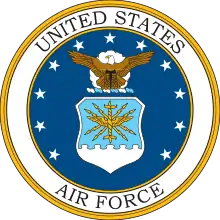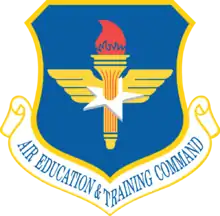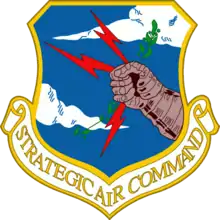12th Flying Training Wing
The 12th Flying Training Wing (12 FTW) is a United States Air Force unit assigned to the Air Education and Training Command (AETC) as part of AETC's Nineteenth Air Force. It is headquartered at Joint Base San Antonio, Texas. The wing is also the parent organization for the 479th Flying Training Group (479 FTG), a geographically separated unit (GSU) located at NAS Pensacola, Florida. The wing is also the parent organization for the 306th Flying Training Group (306 FTG), a geographically separated unit (GSU) located at The United States Air Force Academy, Colorado. The 12 FTW is the only unit in the Air Force conducting both pilot instructor training and combat systems officer training.
| 12th Flying Training Wing | |
|---|---|
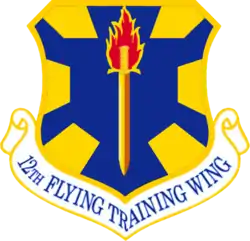 | |
| Active | 1950– present |
| Country | United States |
| Branch | United States Air Force |
| Type | Training |
| Part of | Air Education and Training Command |
| Garrison/HQ | Randolph Air Force Base |
| Engagements |
|
| Decorations | |
| Commanders | |
| Current commander | Colonel Mark S. Robinson |
| Notable commanders | Nicholas Kehoe Lloyd W. Newton |
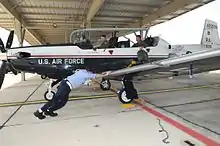
The wing's predecessor unit, the 12th Tactical Fighter Wing, fought in combat during the Vietnam War and was the host unit at two major air bases in South Vietnam. Its McDonnell Douglas F-4 Phantom II aircraft flew thousands of combat missions between 1965 and 1971 before being withdrawn as part of the U.S. withdrawal from Vietnam and Southeast Asia.
Its World War II predecessor unit, the 12th Bombardment Group, as part of Twelfth Air Force, supported the Allied drive from Egypt to Tunisia during the North Africa Campaign, then reassigned to Tenth Air Force in India and flew most of its missions in Burma between April 1944 and May 1945, supporting the British Fourteenth Army.
The commander of the 12th Flying Training Wing is Col Mark S. Robinson. The Command Chief Master Sergeant is Chief Master Sergeant Tony Goldstrom.
1990s
In 1992, due to the impending closure of Mather Air Force Base, California, the 12 FTW also assumed responsibility for Undergraduate Navigator Training (UNT) and Interservice Undergraduate Navigator Training (IUNT) from the 323d Flying Training Wing (323 FTW) at Mather when that organization inactivated, with most T-43A aircraft and some of the 323 FTW squadrons reforming at Randolph AFB under the 12 FTW. In 2009, with the transition of UNT to undergraduate Combat Systems Officer training (UCSOT) and pursuant to earlier Base Realignment and Closure Commission (BRAC) directives, the 12 FTW established a new organization, the 479th Flying Training Group (479 FTG), with two new flying training squadrons and an operations support squadron, as a GSU at Naval Air Station Pensacola, Florida. Although NAS Pensacola is the principal base for student Naval Flight Officer (SNFO) training for the U.S. Navy and U.S. Marine Corps, the 479 FTG operates independently of this program with its own USAF T-6 Texan II and T-1 Jayhawk aircraft. Upon establishment of the 479 FTG at NAS Pensacola, the remaining "legacy" navigator training squadrons that had relocated from the former Mather AFB to Randolph AFB in 1992 were inactivated.
The 2010s
In the second decade of the 21st century, the wing's mission is to provide instructor pilot training in the Raytheon-Beech T-6A Texan II, the Northrop T-38 Talon and the Beech T-1A Jayhawk jet trainers. Previously, the wing also conducted Introduction to Fighter Fundamentals (IFF) in the Northrop AT-38 Talon, a role now performed with T-38s.
Until late 2010, the wing also conducted Joint Specialized Undergraduate Navigator Training (JSUNT) and electronic warfare officer (EWO) training in the T-1A Jayhawk and Boeing T-43A medium-range turbofan jet at Randolph AFB. With the retirement of the T-43 in September 2010, this training merged with extant USAF weapons systems officer (WSO) training that had been conducted jointly with the U.S. Navy and U.S. Marine Corps at Naval Air Station Pensacola, Florida since 1990. The navigator, EWO and WSO training tracks were then merged and all three specialties (which wear the same type of uniform insignia wings upon completion of flight training) became known as Combat Systems Officer (CSO). This updated CSO training is now conducted by the 479th Flying Training Group as a Geographically Separated Unit (GSU) of the 12 FTW at NAS Pensacola utilizing T-6 Texan II and T-1A Jayhawk aircraft.[1]
The wing is responsible for numerous aviation training programs. These programs include Pilot Instructor Training, Combat Systems Officer Training, Remotely Piloted Aircraft Pilot Indoctrination, Basic Sensor Operator Qualification, Airmanship programs for U.S. Air Force Academy cadets, and Introductory Flight Screening.
Units in the 2010s
The wing consists of three flying groups and a maintenance directorate spanning more than 1,600 miles from JBSA-Randolph, Texas to Naval Air Station Pensacola, Florida, to Pueblo Memorial Airport and the U.S. Air Force Academy in Colorado.
The 12th Operations Group controls all Instructor Pilot Training and airfield operations at Randolph AFB and Randolph AFB Auxiliary Field/Seguin Field.
The 479th Flying Training Group is a geographically separated unit located at Naval Air Station Pensacola, Florida and conducts Undergraduate Combat Systems Officer Training.
The 306th Flying Training Group is a geographically separated unit located at the United States Air Force Academy, Colorado. The 306 FTG conducts powered flight training, soaring, and parachute training for Air Force Academy cadets.
|
|
|
Lineage
- Established as 12th Fighter-Escort Wing on 27 October 1950
- Activated on 1 November 1950
- Redesignated: 12th Strategic Fighter Wing on 20 January 1953
- Redesignated: 12 Fighter-Day Wing on 1 July 1957
- Inactivated on 8 January 1958
- Redesignated 12th Tactical Fighter Wing, and activated, on 17 April 1962
- Organized on 25 April 1962
- Inactivated on 17 November 1971
- Redesignated 12th Flying Training Wing on 22 March 1972
- Activated on 1 May 1972 by transfer of personnel and equipment from the 3510th Flying Training Wing
Assignments
|
|
Components
Groups
- 12th Fighter-Escort (later, 12th Operations) Group: 1 November 1950 – 16 June 1952; 15 December 1991–present
- 306th Flying Training Group
- 479th Flying Training Group: 2 October 2009–present
Squadrons
- 1st Flight Screening Squadron: 15 July-15 December 1991
- 27th Air Refueling Squadron: attached 1 April-1 September 1955
- 43d Tactical Fighter: attached 8 November 1965-c. 4 January 1966
- 45th Tactical Fighter: attached 8 May-1 July 1962
- 389th Tactical Fighter: 31 March 1970 – 15 October 1971
- 391st Tactical Fighter: attached 26 January-22 June 1966, assigned 23 June 1966 – 22 July 1968
- 480th Tactical Fighter: 31 March 1970 – 17 November 1971
- 506th Air Refueling Squadron: attached 8 August 1955 – 1 July 1957
- 555th Tactical Fighter: 8 January 1964 – 25 March 1966 (detached 8 December 1964 – 18 March 1965, 6 November 1965 – 25 March 1966)
- 557th Tactical Fighter: 25 April 1962 – 8 November 1965; 1 December 1965 – 31 March 1970
- 558th Tactical Fighter: 25 April 1962 – 31 March 1970 (detached 9 March-16 June 1965, 3 February-22 July 1968)
- 559th Fighter-Escort (later, Strategic Fighter; Fighter-Day; Tactical Fighter): attached 10 February 1951 – 15 June 1952, assigned 16 June 1952 – 8 January 1958; assigned 25 April 1962 – 8 November 1965 (detached 9 June-7 September 1965); assigned 27 December 1965 – 31 March 1970; assigned 1 May 1972 – 15 December 1991
- 560th Fighter-Escort (later, Strategic Fighter; Fighter-Day): attached 10 February 1951 – 15 June 1952, assigned 16 June 1952 – 8 January 1958; 1 May 1972 – 15 December 1991
- 561st Fighter-Escort (later, Strategic Fighter; Fighter-Day; Tactical Fighter): attached 10 February 1951 – 1 April 1952; assigned 16 June 1952 – 8 January 1958 (detached 16 June-16 December 1952)
School
- USAF Navigator School: 14 May 1993 – Nov 2010
- Assumed role from inactivated 323rd Flying Training Wing
- Role assumed by 479th Flying Training Group as a GSU of 12 FTW, Nov 2010
- USAF Navigators now known as USAF Combat Systems Officers
Stations
- Turner AFB, Georgia, 1 November 1950
- Bergstrom AFB, Texas, 5 December 1950 – 8 January 1958
- MacDill AFB, Florida, 25 April 1962 – 31 October 1965
- Cam Ranh AB, South Vietnam, 8 November 1965
- Phù Cát Air Base, South Vietnam, 31 March 1970 – 17 November 1971
- Randolph AFB, Texas, 1 May 1972–present
- Additional GSU at NAS Pensacola, Florida, November 2009–present
- Additional GSU at USAF Academy, Colorado, July 2013 – present
Aircraft
|
|
References
Citations
- Air Force Times, 22 November 2010, p. 20
Bibliography
![]() This article incorporates public domain material from the Air Force Historical Research Agency website http://www.afhra.af.mil/.
This article incorporates public domain material from the Air Force Historical Research Agency website http://www.afhra.af.mil/.
- Martin, Patrick (1994). Tail Code: The Complete History of USAF Tactical Aircraft Tail Code Markings. Schiffer Military Aviation History. ISBN 0-88740-513-4.
- Maurer, Maurer (1983) [1961]. Air Force Combat Units of World War II (PDF). Maxwell AFB, Alabama: Office of Air Force History. ISBN 0-89201-092-4.
- McLaren, David (1998) Republic F-84 Thunderjet, Thunderstreak & Thunderflash: A Photo Chronicle. New York: Schiffer Military/Aviation History, 1998. ISBN 0-7643-0444-5.
- Ravenstein, Charles A. (1984). Air Force Combat Wings, Lineage & Honors Histories 1947–1977. Washington, DC: Office of Air Force History. ISBN 0-912799-12-9.
- Rogers, Brian (2005). United States Air Force Unit Designations Since 1978. Hinkley, England: Midland Publications. ISBN 1-85780-197-0.
